Keywords
|
| FACTS, Power quality, voltage compensation, Radial distribution system, Tie-line, Static Synchronous Compensator (STATCOM),Z-Source Inverter( ZSI). |
INTRODUCTION
|
| Power quality is a major concern in the present era. It becomes especially important with the insertion of sophisticated devices, whose performance is very sensitive to the quality of power supply. A power quality problem is an occurrence manifested as a nonstandard voltage , current or frequency that results in a failure or mis-operation of end user equipments. |
| The analysis of distribution system is an important area of activity as distribution systems provide the final link between the bulk power system and consumers. The Electrical power distribution network becomes more increasingly important and plays an important role in power system planning. A distribution circuit normally uses primary or main feeders and lateral distributors. A main feeder originates from the substation and passes through the major load centers. Lateral distributors connect the individual load points to the main feeder and are defined as radial distribution systems. Radial systems are popular because of their simple design and low cost. |
| Nowadays reliability, stability and high quality besides avoiding interruptions in power supply are major functions to supply loads in the competitive environment of electricity market. So it is needed to design power systems more carefully .New technologies have been looked for to provide such delivery performance. However it may be considered to install an additional device somewhere in the network. This could happened in individual planning stage or later in expansion planning. Such devices are shunt reactors, capacitor banks, series reactors, automatic voltage regulators or recently developed Flexible AC Transmission Systems(FACTS)technology such as static compensator[1]. |
WORKING PRINCIPLE OF STATCOM
|
| The principle of STATCOM operation is as follows: The AC voltage difference across the leakage reactance makes the power exchange between the STATCOM and the power system. The VSI voltage is compared with the AC bus voltage system, when the AC bus voltage magnitude is above that of the VSI magnitude; the AC system sees the STATCOM as inductance connected to its terminals. Otherwise if the VSI voltage magnitude is above that of the AC bus voltage magnitude, the AC system sees the STATCOM as capacitance connected to its terminals. If both AC system and VSI voltage magnitudes are equal, the reactive power exchange is zero. If the STATCOM has a DC source or energy storage device on its DC side, it can supply real power to the power system. This can be achieved by adjusting the phase angle of the STATCOM terminals and the phase angle of the AC power system. When phase angle of the AC power system leads the VSI phase angle, the STATCOM absorbs the real power from the AC system, if the phase angle of the AC power system lags the VSI phase angle, the STATCOM supplies real power to AC system. |
| The Voltage Source Converter or Inverter (VSC or VSI) is the building block of a STATCOM and other FACTS devices. A very simple inverter produces a square voltage waveform as it switches the direct voltage source on and off. The basic objective of a VSI is to produce a sinusoidal AC voltage with minimal harmonic distortion from a DC voltage. Single-line diagram of STATCOM is shown in Fig1. |
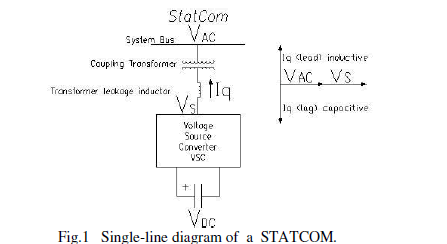 |
| The main advantage of STATCOM compared to the traditional reactive power compensation devices are the ability of strongly regulation ,low harmonic content and low loss without operational problems such as resonance. A STATCOM in association with a particular load can inject compensating current sothat the total demand meets the specification for utility connection. It can also remove any unbalance and harmonic distortion from voltage of utility bus. STATCOM would play a more serious role in power system loadability, reactive power compensation, loss reduction, voltage regulation, voltage balancing and power quality and stability enhancement[2]. |
IMPEDANCE SOURCE INVERTER(ZSI)
|
| The main circuit of configuration of the Z-Source Inverter with load is shown in Fig2. The newly proposed Z-source inverter has a unique feature that it can boost/buck the output voltage by introducing shoot through operation mode, which is forbidden in traditional voltage source inverters, with this unique feature, the ZSI provides a cheaper, simpler, buck-boost inversion by single power conversion stage. The ZSI circuit consists of a diode rectifier, DC link circuit, and an inverter bridge. The differences are that the DC link circuit is implemented by the Z-Source network (c1, c2, L1, and L2) and small input capacitors (ca ,cb , and cc)are connected to the diode rectifier. Since Z-Source Inverter bridge can boost the DC capacitor (c1, and c2) voltage to any value above the DC value of the rectifier, a desired output voltage is always obtainable regardless of line voltage. Using the 230V load system as an example ,the DC capacitor voltage can be boosted to 350V or greater in order to produce 230 V AC output regardless of the line voltage. Theoretically ,the DC capacitor voltage can be boosted to any value above the inherent DC voltage(310-325V for a 230-V line) of the rectifier ,by using the shoot through zero switching states. When a higher voltage is needed or during voltage sags. The capacitor voltage is, however, limited by the device voltage rating in practical use. |
| Network reconfiguration in distribution is dealt by Baran[3].Compensation based power flow for weakly meshed distribution given by Shirmohammadi[4].Load flow solution of Radial distribution network is given by S.Ghosh[5]. Harmonics study and comparison of ZSI with traditional Inverters is given by Justus[6]. solution to power quality problem is given by Mineski[7].Load flow method for weakly meshed system is given by S.Sivanagaraju[8].Comparison of ZSI and Push-pull inverter based STATCOM and Enhancement of power quality are given by Usha [9]-[10]. |
| The authors are unaware of any literature dealing STATCOM using Z-Source Inverter based STATCOM in IEEE 33-bus radial and weakly meshed distribution system. This work gives power quality improvement in IEEE 33-bus radial and weakly meshed distribution system with ZSI based STATCOM. |
 |
SIMULATION RESULTS
|
| The IEEE 33-bus radial and weakly meshed distribution systems are considered for simulation studies. It is assumed that the three-phase radial and weakly meshed distribution networks are balanced. The 33-bus IEEE radial and weakly meshed distribution systems are modeled and simulated using MATLAB/SIMULINK. The loads are distributed uniformly along the line section. All the loads are modeled as constant impedance loads. |
| The single line diagram of 33-bus radial distribution system is shown in Fig 3a.The single line diagram of 33- bus weakly meshed distribution system is shown in Fig3b.The line, load and tie switch data are given in[5].The load flow results of 33-bus radial and weakly meshed system is given in[8].The simulation results in line with load flow results of radial and weakly meshed systems. The load bus voltage is sensed and rectified using an uncontrolled rectifier. It is compared with reference voltage. The error is given to PI controller. The output of PI controller adjusts the pulse width to get the required voltage at the load bus. The SIMULINK model of PI controller, single–phase distribution line , single-phase RL-load and single-phase source are shown in Fig3c,Fig3d,Fig3e and Fig3f respectively |
| The SIMULINK model of 33-bus IEEE radial distribution system without STATCOM is shown in Fig3g.The STATCOM is placed at 6th bus for better compensation for both the cases. The SIMULINK model of 33-bus IEEE radial distribution system with ZSI based STATCOM at 6th bus is shown in Fig3h.In order to improve the level of voltages at various load buses STATCOM is connected at 6th bus in the radial distribution system. The STATCOM is connected to the system at t=0.3sec.The SIMULINK model of 33-bus IEEE weakly meshed distribution system is shown in Fig3i .The SIMULINK model of 33-bus IEEE weakly meshed distribution system with ZSI based STATCOMs at 6th bus is shown in Fig3j.The voltage magnitude at the source bus is considered to be 1.0 pu. |
| The simulation results of 33-bus IEEE Radial distribution system and weakly meshed distribution system as case(a) and case(b) are given in Table 1. The magnitudes of load voltages at load buses for these two cases with and without STATCOM is presented in Table1.From the Table1,it is clear that voltage dip at various load buses are compensated by connecting STATCOM at 6th bus. It was also found that the voltage magnitudes in weakly meshed distribution system are higher than that of radial distribution system because of the inclusion of tie lines. Hence load voltages are improved further in both IEEE 33-bus Radial and weakly meshed distribution system by using ZSI based STATCOM. |
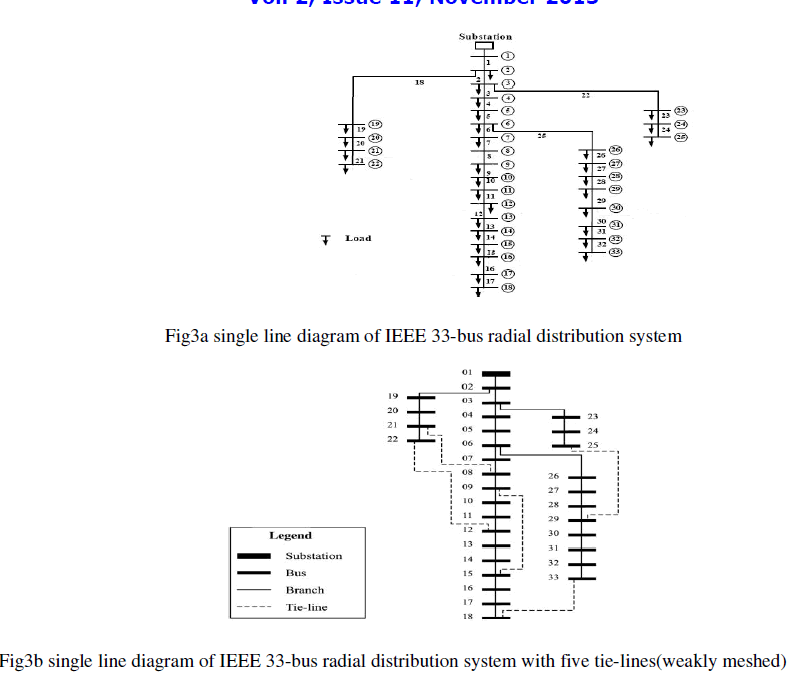 |
(A)SIMULINK model of PI controller
|
| SIMULINK model of PI controller is shown in Fig3c.The load voltage is fed to the summing point. This voltage is compared with reference voltage(set at 5v) and the error is fed to PI controller(with KP=2 and KI=0.5). Output of the PI controller is given to pulse generator to produce the required pulse width. These pulses are given to the STATCOM to inject the voltage into the system for compensation. |
 |
(B)SIMULINK model of single-phase distribution line:
|
| Using SIMULIK 1-Phase Series RLC Branch block (C value set to ∞) and 1-Phase Parallel RLC Branch block (R and L values set to infinity) with V, I and PQ measurement blocks develop distribution line as shown in Fig3d |
 |
(C) SIMULINK model of single-phase RL Load:
|
| Using SIMULIK 1-Phase Parallel RLC Load block with V, I and PQ measurement blocks the model is developed as shown in Fig3e. It exhibits constant impedance at the specified frequency. The load active and reactive powers are proportional to the square of the applied voltage. Capacitive VAR QC value is set to 0 for getting 1-Phase RL load. |
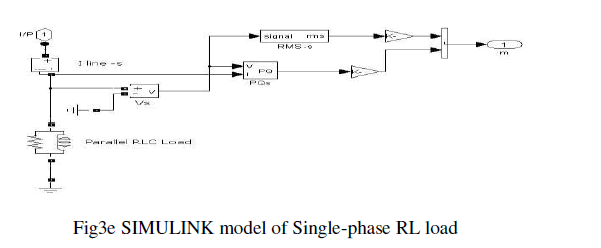 |
(D) SIMULINK model of a single phase source:
|
| Using SIMULIK 1-Phase AC source, 1-Phase Series RLC Branch block (R value set very low value 1e-12, L value set zero and C value set to ∞) and 1-Phase Parallel V, I and PQ measurement blocks develops single phase source model as shown in Fig3f. Here very low value of resistance is connected in series to avoid convergence problem. |
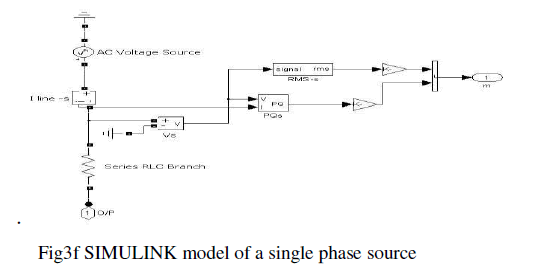 |
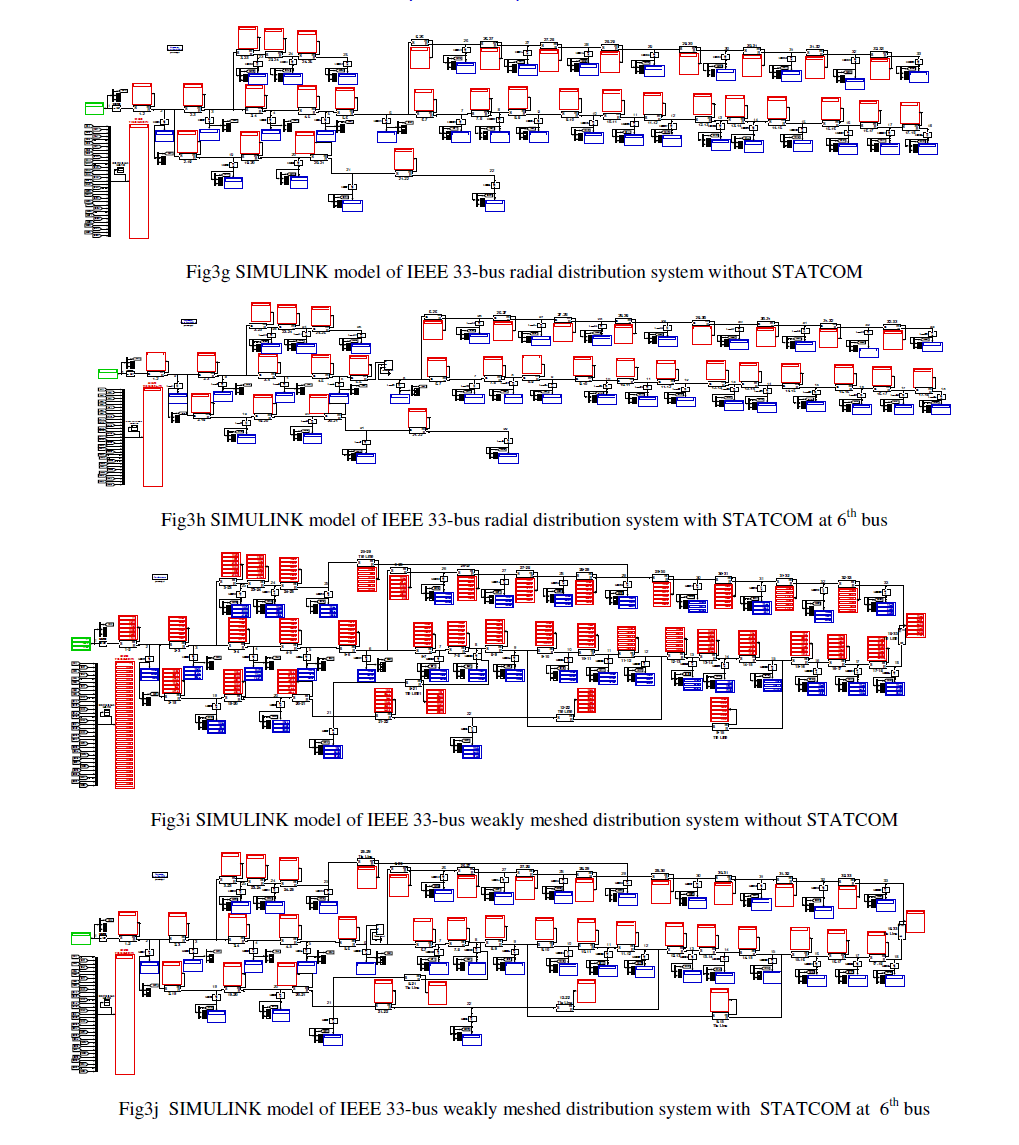 |
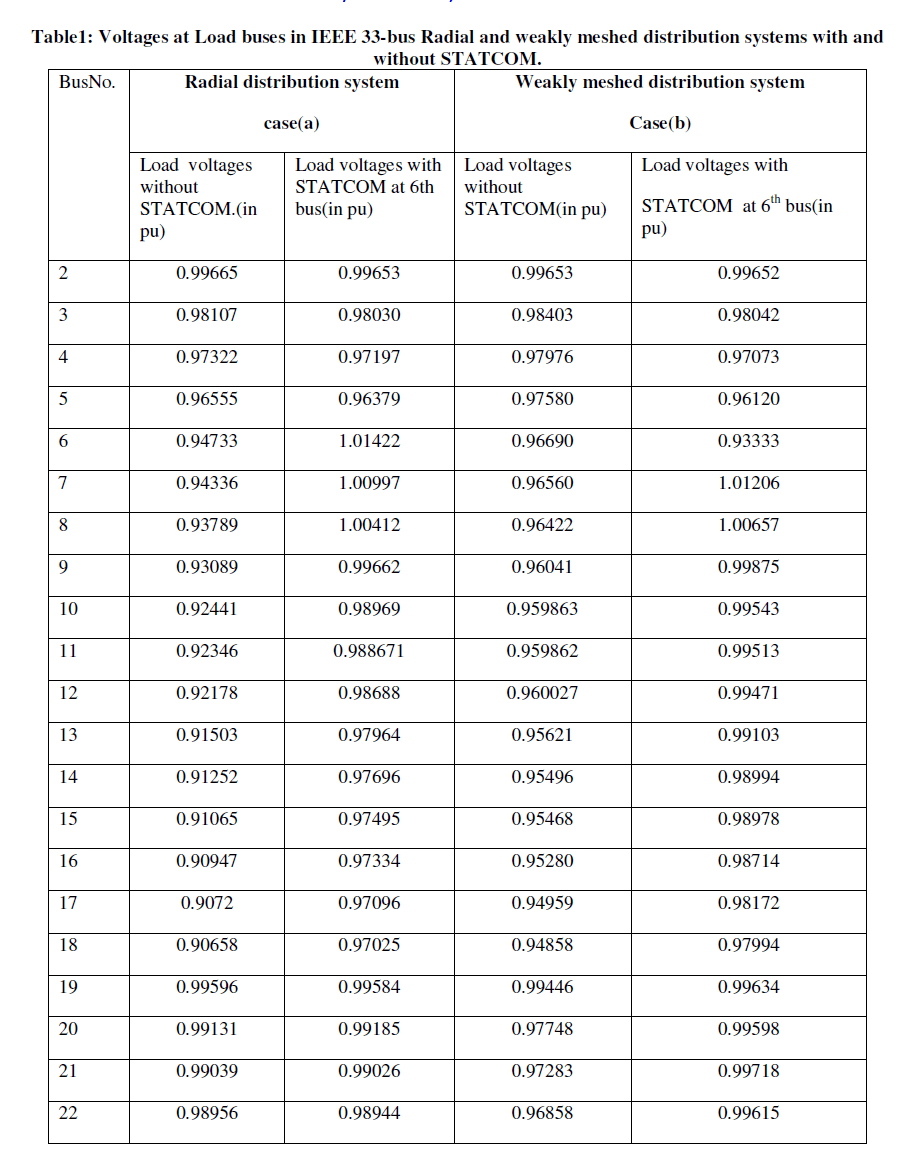 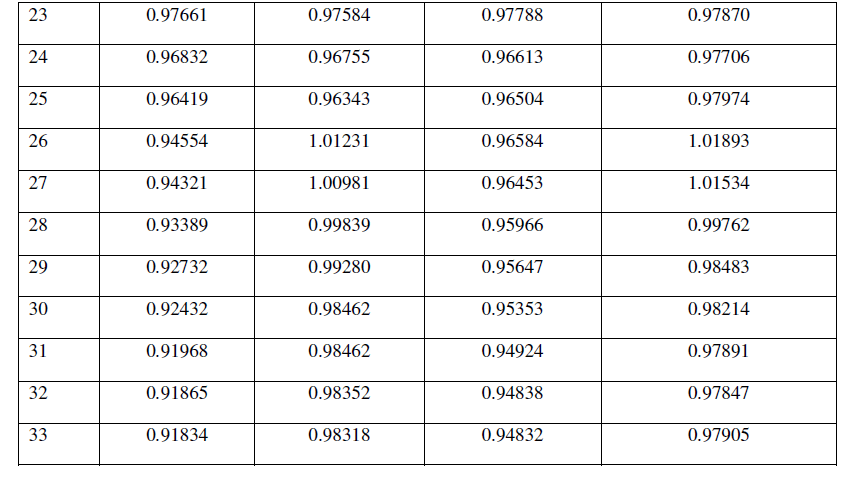 |
CONCLUSION
|
| This work presents the possibility of using Z-Source Inverter based STATCOM system. The 33-bus IEEE radial and weakly meshed distribution systems are modeled and simulated using MATLAB/SIMULINK and results are presented. The simulation results of 33-bus IEEE radial and weakly meshed distribution systems with and without STATCOM are presented. Simulation studies were done using single phase model of balanced three phase system. It is found that voltage compensation is done by connecting the STATCOM. Both IEEE radial and weakly mesh distribution system have improved power quality. The radial distribution system with five tie-lines has further improved reliability compared with radial distribution system. The scope for future work is simulation can also be done using PSCAD or PSIM. The simulation studies can be extended to 64-bus and 128-bus systems. Testing can also be done on extremely large real time power systems and also the laboratory model for STATCOM can be done using Micro-controller or DSP processor. |
References
|
- N.G.Hingorani and L.Gyugyi, understanding FACTS, Concepts and technology of Flexible AC Transmission systems, Piscataway, NJ;IEEE Press, 2000.
- A.Ghosh and G.Ledwich ,Power Quality Enhancement using custom power Devices, Kluwer Academic Publishers,2002.
- Baran M.E and Wu F F.1989.Network Reconfiguration in distribution systems for loss reduction and load balancing. IEEE TransonPERD,PWRD-(2),pp.1401-107,1989.
- ShirmohammadiD,HongHW,SemlyenA,LuoGX.Compensation based power flow method for weakly meshed distribution networks.IEEE Trans. On Power Syst.3(2):753-762,1988.
- S.Ghosh and D.Das Method for load flow solution of Radial distribution networks.IEE PartC,146(4):641,1994
- B.Justus Rabi and Arumugam”, Harmonics study and comparison of Z-Source inverter with Traditional Inverters”, American journal ofApplied sciences2(10):1418-1426,2005.
- R.Mienski,R.Pawelek and I.Wasiak, “Shunt compensation for power quality improvement using a STATCOM controller: Modelling andsimulation”,IEEEProce., vol.151,No.2,March2004.
- S.Sivanagaraju,J.Viswanatha and M.Giridhar, “A loop based load flow method for weakly meshed distribution network,” ARPN J.ofEngineering and Applied sciences,vol.3,no.4,pp.55-59.Aug.2008.
- N.Usha and M.Vijayakumar “Comparison of pus-pull and Z-source Inverter based STATCOM systems”, International Journal ofElectronics and Electrical Engineering,Vol.6,Number1,pp.55-65,2013.
- N.Usha and M.Vijayakumar “Enhancement of power Quality in Thirty Bus system using ZSI based STATCOM” International Journal ofModern Engineering Research,vol.3,Issue.2 pp-773-778. March-April.2013
|